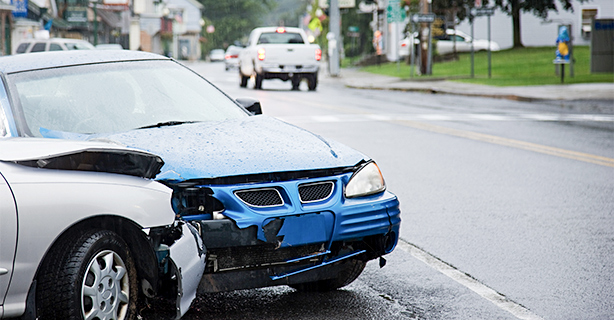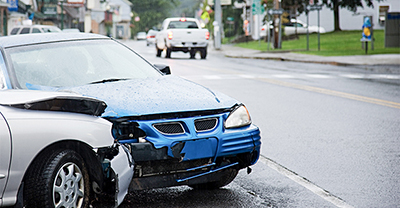Liability vs. “full coverage” car insurance


0 min. read
What’s the difference between liability and “full coverage” car insurance?
Liability insurance can help cover injuries and damage you cause to other people’s vehicles. “Full coverage” car insurance policies include additional, optional coverages—typically collision and comprehensive coverages—that can help protect your own property.
The term "full coverage" car insurance is often used in the auto insurance industry, but it's important to note that it's not actually a type of insurance product.
What does “full coverage” mean in car insurance?
For the purposes of this article, we use the term “full coverage” to mean a policy that includes, at minimum:
Bodily injury liability
Property damage liability
Collision
Comprehensive
Liability vs. “full coverage” insurance cost
When it comes to liability vs. "full coverage" car insurance, determining the cost/benefit is ultimately up to you.
Is liability insurance cheaper than “full coverage” insurance?
Whether or not “full coverage” is cheaper than liability-only insurance depends on how you measure cost. If you’re thinking in terms of premiums alone, liability-only will nearly always be cheaper than “full coverage” insurance because “full coverage” includes more coverages.
So, while you hope to never need it, “full coverage” insurance can potentially save you a significant amount of money if you’re ever involved in an accident where your vehicle is damaged.
“Full coverage” vs. liability car insurance: Which do I need?
While liability auto insurance is legally required in nearly every state, “full coverage” isn’t. But there are scenarios in which carrying “full coverage” may be the right choice for you.
For example, if you’re looking to buy a new or preowned vehicle and need to borrow from a lender like a bank or even an auto dealer, they may require you to carry collision and comprehensive coverages as well—which, combined with liability, typically makes up “full coverage.”

What is liability-only car insurance?
Liability-only car insurance includes two areas of coverage: bodily injury liability and property damage liability.
Bodily injury liability insurance
Bodily injury liability can help cover another party’s medical expenses in a covered accident you cause, whether they’re another motorist, a passenger, or a pedestrian.
Due to the costs of healthcare, bodily injury claims tend to be more expensive than property damage claims. Since each vehicle can hold at least one passenger, insurance companies provide two coverage limits: per-person and per-accident coverage.
Insurance providers list their coverage limits in this format: 25/50/25. These numbers represent thousands of dollars (so, “25” means $25,000). Here’s what each number indicates:
Coverage limit | Definition |
25 | The amount of bodily injury liability coverage per person |
50 | The amount of bodily injury liability coverage per accident |
25 | The amount of property damage liability coverage per accident |
Let’s say you have 25/50/25 liability insurance:
If you’re at fault in a car accident and one person is injured, your insurance would cover up to $25,000 for their bodily injury.
If multiple people are injured, your coverage would be capped at a total of $50,000 for bodily injury in the entire accident.
Additionally, your insurance would cover up to $25,000 for property damage resulting from the accident.
If the total costs for bodily injury and property damage exceed these coverage limits, you may be personally responsible for the remaining expenses.
Property damage liability
Property damage liability is always structured on a per-accident basis and only covers damage you cause to another person’s property.
Using the hypothetical 25/50/25 policy above, if you cause an accident that results in $50,000 worth of damage to someone else's property, your property damage liability insurance could help cover up to $25,000 of those damages, but you would be liable for the other $25,000.
So what happens if someone else is at fault in an accident and they damage your property? Since most states require all motorists to carry liability insurance—both bodily injury and property damage—the other person’s property damage liability coverage will help pay for the damage they caused to your property. Your own liability coverage doesn’t apply in this scenario.
State-required insurance
Auto insurance can help protect you from financial loss due to an accident you cause, but there’s more to it than that. In most states, liability insurance is actually legally required for all drivers.
Each state has its own requirements for car insurance—both the coverages they require and the mandatory minimum limits drivers need to carry. Be sure you’re familiar with your state’s car insurance requirements, but keep in mind the cost of an accident can quickly surpass your state’s minimum coverages.

What’s covered under liability insurance?
Liability insurance covers many of the costs that may arise out of an accident you cause. Your policy’s coverage limit is the maximum dollar amount the policy will pay out for an accident, which means you’re legally responsible for any costs that exceed your coverage.
Your bodily injury liability coverage helps pay for injury-related expenses following an accident you cause. This may include:
Hospital bills and medicine
Loss of income due to the injury
Pain and suffering payments
Your property damage liability insurance can help repair or replace damaged property if you’re at-fault in the accident that damaged it. Types of covered property may include:
Vehicles
Storefronts
Trees
Public property like bridges and road signs
What’s not covered under liability insurance?
The biggest distinction between liability and “full coverage” insurance is that liability doesn’t cover damage to your own property. For example, if you hit a patch of ice while driving and rear-end another vehicle, your liability insurance would only help pay for damage to the other vehicle—not your own.
Another important exception to liability insurance is it doesn’t help protect your car from incidents like vandalism or theft.
What happens if my car is totaled and I only have liability insurance?
If your car is totaled in an accident somebody else is at fault for, you should file a claim with their insurance provider. The at-fault person’s insurer—not yours—is responsible for paying for the vehicle damage.
If your car is totaled in an accident you’re at fault for, you’ll have to pay out-of-pocket to replace it. That’s one important consideration to carrying “full coverage” insurance (which includes collision coverage)—it helps pay for damage to your own vehicle, regardless of who’s at fault in the covered accident.

What’s covered by “full coverage” car insurance?
Remember, there isn't a policy available that protects you from every possible loss. When people use that term, they typically mean a policy that includes collision and comprehensive in addition to bodily injury liability and property damage liability.
Collision insurance coverage
True to its name, collision coverage helps you pay for damages due to collisions—including accidents you’re at fault for or the at fault driver doesn’t have the coverage to pay to fix your vehicle.
Comprehensive insurance coverage
Comprehensive insurance covers damage caused by non-collisions—that’s why some car insurance companies call comprehensive coverage “other than collision” coverage. This includes:
Theft
Vandalism
Fire
Falling objects like hail
Hitting a deer
Just like collision coverage, your state doesn’t require comprehensive coverage, but if you finance or lease your car, your lender might require it.
What’s not covered by “full coverage” auto insurance?
Like we noted above, the term “full coverage” isn’t actually a type of car insurance coverage. “Full coverage” doesn’t mean everything under the sun is covered. For example, “full coverage” typically may not cover damages arising from:
Illegal activities like street racing
Intentional damage
Catastrophes like war
A “full coverage” policy might not cover bodily injury caused by an uninsured motorist. That’s why most insurance companies sell uninsured motorist (UM) and underinsured motorist (UIM) coverages. Some states require these coverages, and others will automatically add them to your policy and only remove them if you specifically reject them in writing.
“Full coverage” insurance also doesn’t cover expenses:
Below your deductible
Above your coverage limit
Liability only vs. “full coverage” insurance: Which is best for me?
Ultimately, the decision between liability and “full coverage” depends on your individual needs and budget. If you have a newer or more expensive vehicle, “full coverage” may provide the peace of mind you need. However, if you have an older vehicle that's paid off and you're looking to save money, liability insurance may be a good option.
How much car insurance coverage you need
Try to purchase the best—and most—car insurance you can afford. That could mean exceeding your state’s minimum liability limits and buying additional coverages like collision and comprehensive insurance.
At the end of the day, the coverage that’s best for you is the coverage that best fits your budget and your situation.
“Full coverage” vs. liability FAQs
As vehicles get older, their value tends to decrease. At a certain point, you could decide that paying “full coverage” car insurance premiums for a vehicle that’s lost much of its value may not be worth it.
There’s no one-size-fits-all answer to this question, but if you’re worried you’re paying for more car insurance than you need, talk to your agent to see if they think dropping your collision and comprehensive coverages may be the right call.
The only real disadvantage of “full coverage” car insurance is the possibility that you may be paying for more car insurance than you need, given your vehicle’s value and your financial situation. Compared to liability-only car insurance, “full coverage” policies typically come with more expensive monthly premiums and higher deductibles.
You can make changes to your policy any time you want. This includes switching from liability-only to “full coverage” insurance, as well as switching back. Give us a call at 800-334-0090 to update your policy or talk to one of our knowledgeable customer support team members.
The decision of whether to drop your “full coverage” is entirely yours, and it depends on your vehicle, your finances, and your risk tolerance. Most drivers who drop “full coverage” in favor of liability-only policies do so because their vehicles have gotten older and decreased in value, they want to save money on their car insurance, or they’ve otherwise found “full coverage” to be unnecessary.
The general information in this blog is for informational or entertainment purposes only. View our blog disclaimer.
*Data accuracy is subject to this article's publication date.










